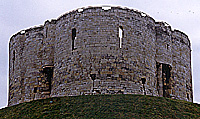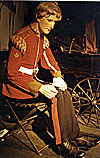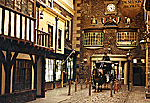A short two blocks away from the Jorvik Viking Centre resides the York Castle Museum, an absolutely superb museum containing a significant number of displays and items. Although you can walk briskly through the museum in about an hour and a half, you really should expect to spend at least double that time in order to discover all that the museum offers.
Originally, we were not going to visit the museum, but since the Jorvik Viking Centre did NOT contain the Coppergate Helm, and the Castle Museum did, off we went to view one of the few intact Dark Age helms.
Contrary to its name, the York Castle Museum is not in a castle, but in an area where there once was a castle. A pair of buildings connected by an enclosed walkway that not only displays the helm, but also serves as an entrance.
 Part of the castle, now called Clifford's Tower, sits across a grassy courtyard from the museum.
Part of the castle, now called Clifford's Tower, sits across a grassy courtyard from the museum.
Large Photo of Tower and Courtyard (66K)
At right, top, Clifford's Tower as seen from the front door of Castle Museum. At right, bottom, closer view of the tower.
After paying the entrance fee, one-way path leads you through the six huge floors of the museum. The guidebook notes 3,000 square meters of floor space, although the cases are filled with enough items to make it seem 10 times the size. Unlike the Smithsonian or British Museum style, where you can pretty much walk where you want, the layout sends you to one section after another sequentially--no random access exhibits, although you can certainly retrace your steps. In certain areas of the museum, with its grand balconies, you will do just that, as you spy something from above you missed below.
There is a touch and feel mystery room, primarily for children but amusing for big kids too, where you can see all sorts of odd items, as well as quite common items found in the kitchen, parlour, and other parts of any house. One wall has a line of boxes with a hole in the front--akin to a birdhouse. The idea is to stick your hand in the box, feel the object inside, and try to guess what the object is. It is a bit more difficult that it first seems. After you guess, you lift the lid to reveal the object.
It turns out it was attached to the end of a bayonet (at right) during WWI so you could peer out of the trench without being shot.
I call the common objects, tools, and so on of everyday life in the US "Americana." Since the York Castle Museum is in Britain, I should call the collections in the next few rooms, "Britainiana."
Much of it concerns relatively modern life--modern in the sense of 20th century as you wander through a large gallery filled with kitchen utensils, photography equipment, cards and boardgames, and so on. Then on to a variety of furnishings and down the stairs to the farm house and barn recreations, farm implements, tools, and so on.
W. Foster the Toyman shows trains, bowling pins, teasets, steam engines, and other toys. The bank features richly decorated interior. The Police station seems to indicate the jailer didn't have much better working conditions than the inmates.
More York
This article appears in MagWeb (Magazine Web) on the Internet World Wide Web. It's an old motte and bailey design sitting atop a knoll. It is open to the public from 10am to 6pm for a small fee of £ 1.60 per person, but we were too late to get in as we spent just over an hour inside the YCM.
It's an old motte and bailey design sitting atop a knoll. It is open to the public from 10am to 6pm for a small fee of £ 1.60 per person, but we were too late to get in as we spent just over an hour inside the YCM.
Enter the Museum
Victorian Start
 The first part takes you through a Victorian era gallery displaying a variety of costumes, furnishings, and other items from the 19th century. Slowly, a time shift occurs as you wander along the path, gradually winding through rooms that take you up to more or less modern days--1960s-70s room.
The first part takes you through a Victorian era gallery displaying a variety of costumes, furnishings, and other items from the 19th century. Slowly, a time shift occurs as you wander along the path, gradually winding through rooms that take you up to more or less modern days--1960s-70s room.
![]()
 Among the most unusual objects in the room was an interesting little mirror (at left) about a few inches long by a couple inches wide with an odd-shaped bracket. There was the usual question of what this was used for. You could see it was a mirror, but the bracket really caused a bit of a mystery.
Among the most unusual objects in the room was an interesting little mirror (at left) about a few inches long by a couple inches wide with an odd-shaped bracket. There was the usual question of what this was used for. You could see it was a mirror, but the bracket really caused a bit of a mystery.
More Britainiana
 Then, you descend into a reconstructed street from Victorian times, complete with full-sized horse-drawn coach. Kirkgate Street looks like you either stepped back in time or onto a Hollywood movie set. It has a cobblestoned street with smooth sidewalks. Clock shops, toy shops, clothiers, general store, post office, bank, and other stores line both sides of the street. Talk about a window-shopping experience.
Then, you descend into a reconstructed street from Victorian times, complete with full-sized horse-drawn coach. Kirkgate Street looks like you either stepped back in time or onto a Hollywood movie set. It has a cobblestoned street with smooth sidewalks. Clock shops, toy shops, clothiers, general store, post office, bank, and other stores line both sides of the street. Talk about a window-shopping experience.
York Introduction
Jorvik Viking Centre
Castle Museum (part 1)
Castle Museum (part 2)
Walk Around York (part 1)
Walk Around York (part 2)
Map of York (Large: 152K)
Back to List of Historical Sites
Back to Travel Master List
Back to MagWeb Master List of Magazines
© Copyright 1998 by Coalition Web, Inc.
Other military history articles and gaming articles are available at http://www.magweb.com